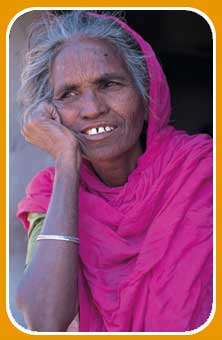
�Jeremy
Horner/Panos Pictures. |
Despite 50 years
of aid, almost half the world's people still live on less
than �1.30 a day. In an increasingly interdependent
world greater contact between people makes the widening
gap between rich and poor appear more stark, and the need
to tackle poverty more urgent. |
New
goals for the new Millennium
In November 2000, world leaders set out goals to halve the
number of people living in poverty by 2015. To meet these
'Millennium Development Goals' governments in many rich countries
are taking a fresh look at their aid budgets. The events of
September 11th 2001 added weight to the need for more aid
- more people will stay poor following the economic slowdown
after September 11th. Anger and frustration is growing amongst
the poor as they feel unable to share the wealth enjoyed by
others. This could create a fertile ground for terrorism,
and a threat to future peace and security.
|
"We
live in one world, not two. No-one in this world can
feel comfortable or safe, while so many are suffering
and deprived".
Kofi
Annan, UN Secretary-General, March 2002.
|
 to
find out the Millennium Development Goals. to
find out the Millennium Development Goals.
New Promises
Since 1997, the UK government's aid budget has grown by 45%.
 to find out which countries are the main recipients of UK
aid.
to find out which countries are the main recipients of UK
aid.
Roughly half known as
'bilateral aid' goes directly to individual countries. The
other half is 'multilateral', channelled through international
bodies like the EU and the World
Bank. More aid now flows through NGOs
that act on behalf of donors and work with local people. Visit
www.oxfam.org
and www.actionaid.org
to find out about the work of two of these NGOs.
In March 2002, the EU
and the USA announced an extra �8 billion a year of
aid by 2006. But according to the World
Bank, aid will need to double in order to achieve the
Millennium Goals. And there are still only five MEDCs
that spend more than the UN's minimum target of 0.7% of GNP
on aid.
 to
find out which countries give what. to
find out which countries give what.
Strings

�JC Tordai/Panos Pictures
|
Israel receives
about �2 billion in US aid, 60% as military support. |
 to
find out other countries that are the biggest recipients of
US aid. to
find out other countries that are the biggest recipients of
US aid.
Quality as well as quantity
of aid is important. Click on the boxes below to find out
how aid can vary in quality.
New Partnerships
The UK government is also changing the way it distributes
aid. Instead of spending it on one-off development projects,
more aid goes directly to governments in poor countries. Local
people should be involved too. By recognising people's right
to decide for themselves how to improve their quality of life,
aid is much more likely to have a sustainable
impact. In return, governments have to draw up their own master
plans called 'poverty reduction strategies' to co-ordinate
different kinds of aid and to justify how the aid will help
the poor.
Another partnership between the rich world and African countries
called NePAD aims to reduce poverty in Africa.
 to
find out more. to
find out more.
Barriers to development
Despite more and better aid, rich countries are still giving
with one hand and taking more with the other.
Rising poverty should
concern everyone, and recent changes that channel more aid
towards fighting poverty are a step in the right direction.
At the same time, more people are demanding a fairer playing
field in international trade to reduce poverty. Visit the
Make Trade Fair page to find out
more.
|





